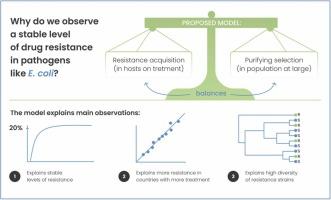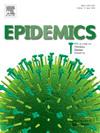Explaining the stable coexistence of drug-resistant and -susceptible pathogens: the resistance acquisition purifying selection model
IF 2.4
3区 医学
Q2 INFECTIOUS DISEASES
引用次数: 0
Abstract
Drug resistance is a problem in many pathogens. While overall, levels of resistance have risen in recent decades, there are many examples where after an initial rise, levels of resistance have stabilized. The stable coexistence of resistance and susceptibility has proven hard to explain – in most evolutionary models, either resistance or susceptibility ultimately “wins” and takes over the population. Here, we show that a simple model, mathematically akin to mutation-selection balance theory, can explain several key observations about drug resistance: (1) the stable coexistence of resistant and susceptible strains (2) at levels that depend on population-level drug usage and (3) with resistance often due to many different strains (resistance is present on many different genetic backgrounds). The model is applicable to resistance due to both mutations and horizontal gene transfer (HGT). It predicts that new resistant strains should continuously appear (through mutation or HGT and positive selection within treated hosts) and disappear (due to a fitness cost of resistance). The result is that while resistance is stable, which strains carry resistance is constantly changing. We used data from a longitudinal genomic study on E. coli in Norway to test this prediction for resistance to five different drugs and found that, consistent with the model, most resistant strains indeed disappear quickly after they appear in the dataset. Having a model that explains the dynamics of drug resistance will allow us to plan science-backed interventions to reduce the burden of drug resistance.

解释耐药和敏感病原体稳定共存:耐药性获得纯化选择模型
耐药性是许多病原体存在的问题。虽然总体而言,近几十年来耐药性水平有所上升,但有许多例子表明,在最初的上升之后,耐药性水平已经稳定下来。抗药性和易感染性的稳定共存已被证明是难以解释的——在大多数进化模型中,抗药性或易感性最终“胜出”并接管种群。在这里,我们展示了一个简单的模型,在数学上类似于突变选择平衡理论,可以解释关于耐药性的几个关键观察:(1)耐药菌株和敏感菌株的稳定共存(2)依赖于人群水平的药物使用水平;(3)通常由许多不同的菌株引起的耐药性(耐药性存在于许多不同的遗传背景)。该模型适用于突变和水平基因转移(HGT)引起的抗性。它预测新的耐药菌株将不断出现(通过突变或HGT和处理宿主内的阳性选择)并消失(由于抗性的适应度成本)。结果是,虽然抗性是稳定的,但哪些菌株携带抗性是不断变化的。我们使用来自挪威大肠杆菌纵向基因组研究的数据来测试对五种不同药物耐药性的预测,并发现,与模型一致,大多数耐药菌株在出现在数据集中后确实很快消失了。拥有一个解释耐药性动态的模型将使我们能够计划有科学依据的干预措施,以减轻耐药性的负担。
本文章由计算机程序翻译,如有差异,请以英文原文为准。
求助全文
约1分钟内获得全文
求助全文
来源期刊

Epidemics
INFECTIOUS DISEASES-
CiteScore
6.00
自引率
7.90%
发文量
92
审稿时长
140 days
期刊介绍:
Epidemics publishes papers on infectious disease dynamics in the broadest sense. Its scope covers both within-host dynamics of infectious agents and dynamics at the population level, particularly the interaction between the two. Areas of emphasis include: spread, transmission, persistence, implications and population dynamics of infectious diseases; population and public health as well as policy aspects of control and prevention; dynamics at the individual level; interaction with the environment, ecology and evolution of infectious diseases, as well as population genetics of infectious agents.
 求助内容:
求助内容: 应助结果提醒方式:
应助结果提醒方式:


